
Sen. Jim Inhofe (R-Okla.) speaks during a congressional reception for the Sgt. Maj. of the Army Daniel A. Dailey at the Dirksen Senate Office Building in Washington on March 25, 2015. Army photo by Eboni L. Everson-Myart.
In his first official speech as chairman of the Senate Armed Services Committee, Sen. James Inhofe (R-Okla.) outlined his six priorities for the committee moving forward.
First, he said, the National Defense Strategy will “serve as a blueprint” for everything the committee does. Though he spent eight years on the House Armed Services Committee and 24 hours in SASC, Inhofe said the bipartisan strategy is the best he’s ever seen.
“Everyone varnishes the truth around this country and they don’t let people know the real threat out there,” but the NDS clearly warns that America is losing its advantage, Inhofe said.
His second priority is to rebuild readiness and the third is to modernize US forces to prepare for the renewed great power competition.
For the Air Force, he said, this means modernizing its fighter, bomber, and intelligence, surveillance, and reconnaissance fleets. As the US has spent the last two decades focused on counter terrorism operations, China and Russia have used that time to modernize their own forces. “Unfortunately, they’ve been doing a good job,” Inhofe said. “They are doing things better than we can do it and America’s military advantage has eroded in key warfighting areas such as power projection, cyber, space, electronic warfare, air and missile defense, submarine warfare, long-range ground-based fires,” he said.
Inhofe said he also wants to see increased investments in “key technologies,” such as artificial intelligence, quantum science, and hypersonics.
Fourth, the US must care for its service members, which he said includes everything from educating military children to quality medical care. Fifth, SASC will remain focused on defense and acquisition reform. And finally, he said, “all of these priorities require resources,” so the committee will remain committed to “returning to strategy-driven” defense budgets.